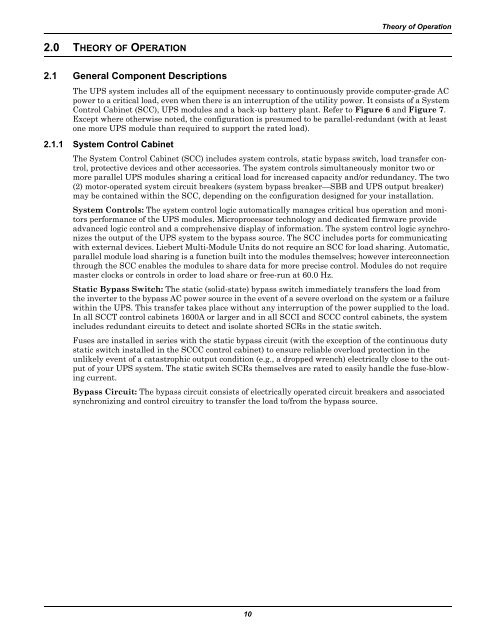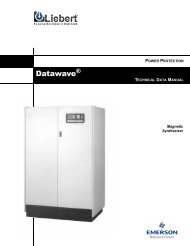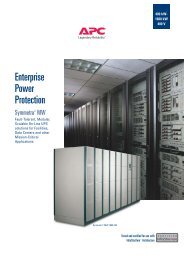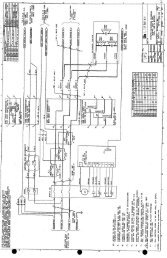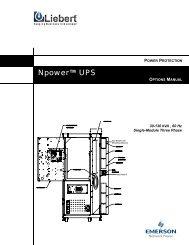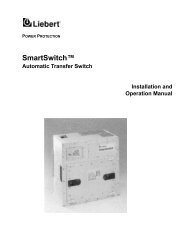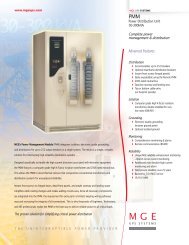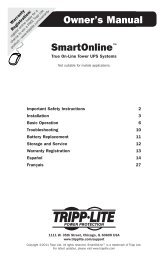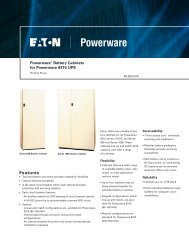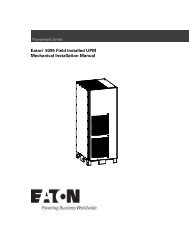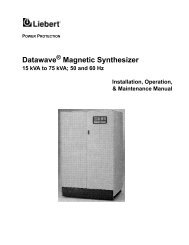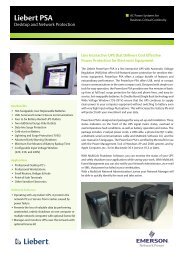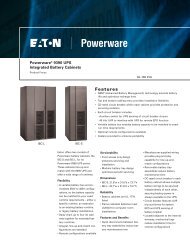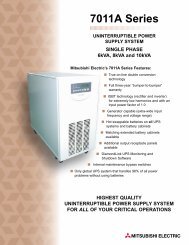Liebert® Series 610™ UPS - Jonweb.net
Liebert® Series 610™ UPS - Jonweb.net
Liebert® Series 610™ UPS - Jonweb.net
You also want an ePaper? Increase the reach of your titles
YUMPU automatically turns print PDFs into web optimized ePapers that Google loves.
Theory of Operation<br />
2.0 THEORY OF OPERATION<br />
2.1 General Component Descriptions<br />
The <strong>UPS</strong> system includes all of the equipment necessary to continuously provide computer-grade AC<br />
power to a critical load, even when there is an interruption of the utility power. It consists of a System<br />
Control Cabi<strong>net</strong> (SCC), <strong>UPS</strong> modules and a back-up battery plant. Refer to Figure 6 and Figure 7.<br />
Except where otherwise noted, the configuration is presumed to be parallel-redundant (with at least<br />
one more <strong>UPS</strong> module than required to support the rated load).<br />
2.1.1 System Control Cabi<strong>net</strong><br />
The System Control Cabi<strong>net</strong> (SCC) includes system controls, static bypass switch, load transfer control,<br />
protective devices and other accessories. The system controls simultaneously monitor two or<br />
more parallel <strong>UPS</strong> modules sharing a critical load for increased capacity and/or redundancy. The two<br />
(2) motor-operated system circuit breakers (system bypass breaker—SBB and <strong>UPS</strong> output breaker)<br />
may be contained within the SCC, depending on the configuration designed for your installation.<br />
System Controls: The system control logic automatically manages critical bus operation and monitors<br />
performance of the <strong>UPS</strong> modules. Microprocessor technology and dedicated firmware provide<br />
advanced logic control and a comprehensive display of information. The system control logic synchronizes<br />
the output of the <strong>UPS</strong> system to the bypass source. The SCC includes ports for communicating<br />
with external devices. Liebert Multi-Module Units do not require an SCC for load sharing. Automatic,<br />
parallel module load sharing is a function built into the modules themselves; however interconnection<br />
through the SCC enables the modules to share data for more precise control. Modules do not require<br />
master clocks or controls in order to load share or free-run at 60.0 Hz.<br />
Static Bypass Switch: The static (solid-state) bypass switch immediately transfers the load from<br />
the inverter to the bypass AC power source in the event of a severe overload on the system or a failure<br />
within the <strong>UPS</strong>. This transfer takes place without any interruption of the power supplied to the load.<br />
In all SCCT control cabi<strong>net</strong>s 1600A or larger and in all SCCI and SCCC control cabi<strong>net</strong>s, the system<br />
includes redundant circuits to detect and isolate shorted SCRs in the static switch.<br />
Fuses are installed in series with the static bypass circuit (with the exception of the continuous duty<br />
static switch installed in the SCCC control cabi<strong>net</strong>) to ensure reliable overload protection in the<br />
unlikely event of a catastrophic output condition (e.g., a dropped wrench) electrically close to the output<br />
of your <strong>UPS</strong> system. The static switch SCRs themselves are rated to easily handle the fuse-blowing<br />
current.<br />
Bypass Circuit: The bypass circuit consists of electrically operated circuit breakers and associated<br />
synchronizing and control circuitry to transfer the load to/from the bypass source.<br />
10


